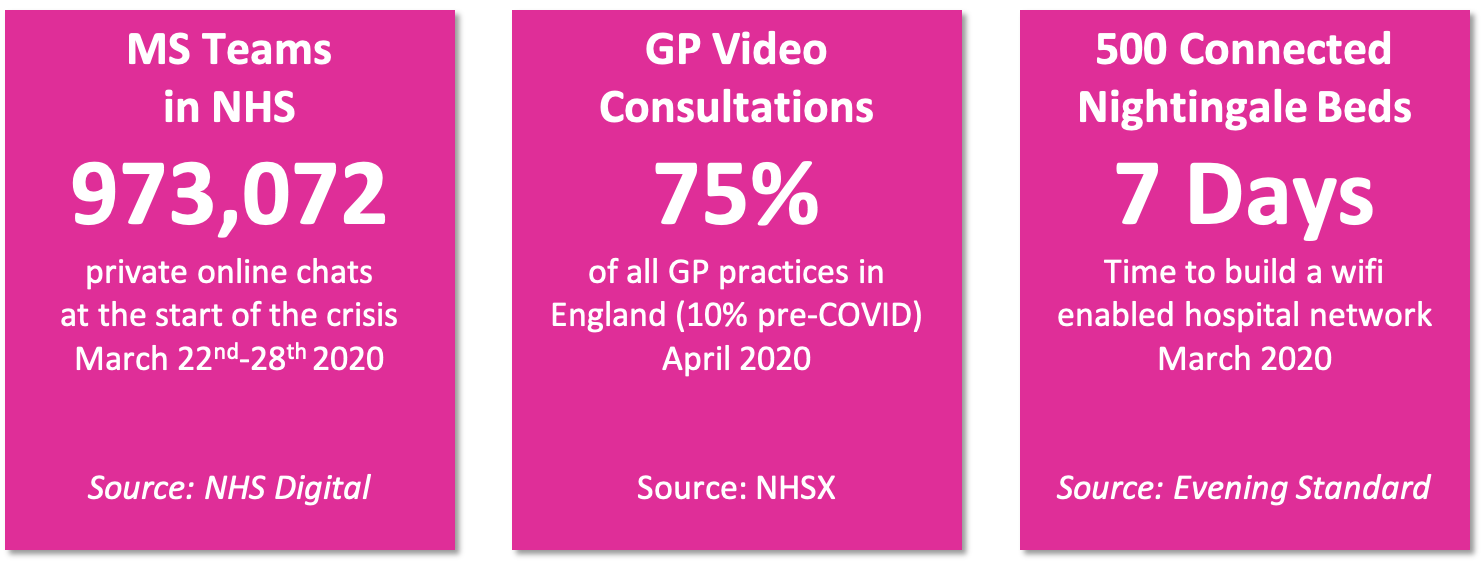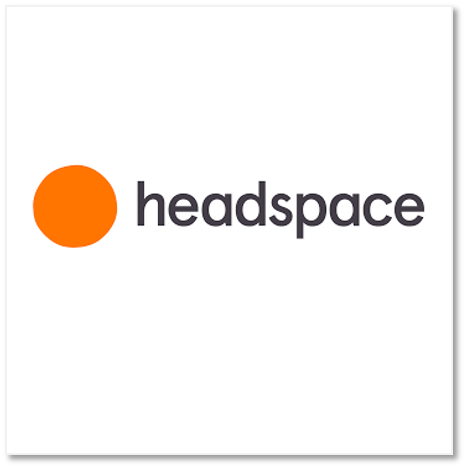Covid-19 has accelerated a number of new approaches for workforces; including the adaptation of new technologies, increased remote and flexible working, and the increased necessity for a focus on mental and physical wellbeing.
As the coronavirus has made change move quickly, we are yet to see what best practice for workforces will look like in a post Covid-19 environment, including for those within the NHS. However, this page details a number of essential areas that business owners, HR directors and workforce management teams will need to consider, both independently and complementary to one another, as they move past Covid-19. You can also download our informative Covid-19 guide by clicking the button below:

Table of contents
What workforce opportunities might the ‘new normal’ present to the NHS?
Across many industries including the NHS, numerous office buildings have been left empty, with staff members instructed to work from home or redeployed to alternate places or positions. How could these estates be managed moving forwards, so as not to leave vacant desks, empty corridors and silent print rooms, if these workforces are deemed to remain working from their homes in the future?
Whilst the outbreak of Covid-19 and lives both affected and lost must be considered as nothing other than a worldwide catastrophe, it also presents the opportunity to move workforces to a new normal, in an accelerated fashion which may have otherwise taken years to implement. For further information on any of these areas, and the support that Liaison Workforce can offer to NHS organisations, please contact 0845 603 9000 or email: info@liaisongroupold.com
Embracing New Technologies
From video conferencing to using online applications, how can communication platforms such as MS Teams, WhatsApp and others assist NHS workforces in collaborating and data sharing? How can such technology platforms become sustainable communication models moving forward?
On 20th March 2020, Microsoft announced that it was making its MS Teams platform available for free to NHS users for three months, with NHS Digital rolling it out to all NHSmail users. The messaging and conferencing app has proved to be a useful tool for connecting NHS workers working remotely, in NHS buildings, or within the community, being used to facilitate 973,072 private online chats between March 22nd–28th according to NHS Digital. Nottingham University Hospitals NHS Trust reported; “Six weeks ago, we had not used MS Teams; yet last week it helped us hold over 3,000 meetings and have more than 40,000 chats – it has now become a regular feature of our daily lives.”
It is currently unknown whether NHS Digital intends to maintain use of the platform at the end of the period, and what the cost will be for licenses to allow access at trusts and health boards across the UK. However, the ability to share and discuss patient data and engage with services users and colleagues on a secure platform will a vital tool in the new normal of operational activity.
Remote communications and video conferencing
A briefing notice sent by NHSX also cleared the use of commercial, off-the-shelf communication and video conferencing platforms to be used for patient consultations, where it reduced the risk of Covid-19 cross-infection. Tools including WhatsApp, FaceTime and Skype were all considered acceptable for use “where there is no practical alternative and the benefits outweigh the risk.” Post Covid-19, whilst this solution will not be beneficial to all patient groups, it is likely that those who are regular tech users, or those with limited time or access issues, will wish to continue making use of this method for GP and other consultations, again marking a shift to a new normal which embraces advances in technology.
In April, it was reported by Tara Donnelly, Chief Digital Officer at NHSX, that over 75% of all GP practices in England had ran video consultations with at least some of their patients, in comparison to less than 10% prior to the Covid-19 outbreak, whilst over 50,000 people had spoken to their hospital doctor via video during the month; “This has happened at an incredible pace, and for the vast majority of patients this is the first time they’ve had a clinical consultation in this way.”
Research conducted in Scotland in 2019, and reported in the British Journal of General Practice on video conferencing for GP appointments found that whilst the Long Term Plan for the NHS was expected to drive change and increase uptake for digital innovations and that a move towards digital innovations for appointments would be favourable amongst some groups of patients, caution was recommended prior to the wide-scale adoption of new technologies. Further research into the possible reduction in certain care elements or consulting time was advised in order to avoid a potential decrease in patient satisfaction. However, the impact of the Covid-19 outbreak has accelerated the use of such technology in the workplace and seen it embraced in preference of visiting a surgery where patients could be exposed to the virus. Without such an accelerant, it is likely that adoption would have taken much longer to be implemented by both GP surgeries and patients.
Connectivity and collaboration
Online or cloud-based collaboration tools have also seen significant uplift over the last 6-8 weeks, enabling both teams and remote workers to access files and embark in online collaboration to increased levels; again changing the landscape of productivity.
At the purpose-built super-surge hospital, NHS Nightingale, at London’s ExCel Centre, technology provider Cisco was tasked with creating a connected hospital in order to cope with the potential influx of patients suffering the effects of Covid-19. Within seven days, the first 500 beds were ready with WiFi access to each one, meaning that patients could be treated either in-person or via video calls. According to David Meads, CEO of Cisco UK and Ireland; “This means you can provide patient care at the bedside, at the nursing stations, or even back at the Barts NHS Trust itself. It’s a fully connected, medical-grade IT infrastructure in just seven days.”
Where patient consultations and medical discussions can also take place remotely, the embracing of technology for the advancement of caring for those in need can truly be appreciated. When such a tool is put to effective use, it is hard to see that this will revert back to previous working methods once the world begins to move on from the coronavirus, leading to sustainability in the use of technology to advance the NHS’s expertise and workforces.

Liaison Workforce’s Commercial Director, Laurence Ansell, says; “Since the outbreak of Covid-19 in the UK, we have been working with a number of NHS trusts and health boards to develop regional collaborative banks to allow the effective deployment of staff throughout regions, in order to maintain staffing levels despite coronavirus-related absence reducing teams at short notice. These can be built quickly, usually within a two-week period, and shows one of the working systems being employed to take a view of workforce needs and how they can be met with existing resources.”
For further information on our workforce solutions, including collaborative banks for your trust or health board, please get in touch on 0845 603 9000 or email: info@liaisongroupold.com
Virtual Workers and Virtual Workspaces
A number of businesses have embraced virtual workspaces for some time, yet some industries have been slow to catch up. Will social distancing allow the benefits of flexible and remote working to be fully embraced, and what impact could this have on recruitment?
The benefits of remote working are widely detailed; from time saved from the absence of a commute, to increased autonomy and a more favourable work/life balance. Whilst a number of businesses have long adopted this approach for many reasons, such as making savings from the lack of commercial property or the need for flexibility in working hours, this has not been the case for the NHS.
As the owners or controllers of over 3,000 properties across the UK, the requirements for remote working has not been necessary in many NHS trusts, as workers have the space to operate within their workspaces. However, the need for social distancing has required many trusts to instruct those who are able to work from home to do so, such as finance teams, administrators, and other non-frontline staff. If those staff members are able to work as productively and efficiently outside of an NHS building, as in other industries, the requirement for them to return may not be essential, potentially leaving some buildings empty or barely used. If this model of remote working becomes the NHS’s new normal where appropriate, could additional funds be raised through the sale of underused buildings, assisting in the long-term acceptance of remote working?
Flexible working
Flexible working, both in terms of working from home and in flexibility of hours worked, would also have benefits for families, those nearing the ends of their career, and many others. Working from home, for all or part of an employee’s working time, would add value to home life balance, especially after Covid-19’s enforced period of isolation and its associated increased working pressures.
As previously discussed, the embracing of new technologies allows the facilitation of a virtual workplace, connecting both workers, and workers with necessary information and data, and making the use of office or in-person working spaces less necessary moving into the future, and allowing social distancing measures to be maintained for a more prolonged period, protecting the workforce for longer.
A further benefit brought about by flexible working is the impact it has on recruitment, and access it provides to the global workforce pool. For an industry with staff shortages, such as within the NHS, the increase in the availability of workers where they can largely remain where they are based increases the opportunity to fill gaps in trusts and health boards. The organisations who embrace this approach to working the quickest will, therefore, obtain the first pick of available specialists, managers, and other roles, which may not have been accessible to them previously.
It should be remembered that having a remote workforce and virtual workspaces are not just a ‘back office’ option, and, as mentioned previously, when positioned alongside an embrace of new technology platforms, may assist NHS medical workers to conduct their clinics virtually, and become more accessible to many patients who may have difficulty in visiting an NHS facility in person, for a multitude of reasons. In a letter from NHS Chief Executive, Simon Stevens, and Chief Operating Officer, Amanda Pritchard, sent to the Chief Executives of all NHS trusts and foundation trusts, CCG Accountable Officers, GP practices and Primary Care Networks, providers of community health services and NHS 111 providers on 29th April 2020, ‘locking in’ the beneficial changes brought about by the pandemic was encouraged, for the future advantage of the NHS: “This includes backing local initiative and flexibility; enhanced local system working; strong clinical leadership; flexible and remote working where appropriate; and rapid scaling of new technology-enabled service delivery options such as digital consultations.”
To find out more, please contact Liaison Workforce on 0845 603 9000 or email: info@liaisongroupold.com

Wellbeing
Covid-19 will leave workforces both depleted and in need of support, and HR Directors and workforce leaders will need to tackle this challenge head-on, particularly in the NHS where many teams have been tackling the effects of the coronavirus from the frontline.
Wellbeing is a broad concept and is often described as relating any number of the following areas:
- physical and mental health and emotional wellbeing
- personal dignity (including treatment of the individual with respect)
- protection from abuse and neglect
- control by the individual over their day-to-day life (including over care and support provided and the way they are provided)
- participation in work, education, training or recreation
- social and economic wellbeing
- domestic, family and personal domains
- suitability of the individual’s living accommodation
- the individual’s contribution to society
There is no hierarchy in the areas of wellbeing listed above – all are equally important. There is also no single definition of wellbeing, and how it is interpreted will depend on the individual, their circumstances and their priorities. Wellbeing encompasses several areas of life, therefore using a holistic approach to ensure a clear understanding of the individual’s views is vital to identifying and defining wellbeing in each case.
Tools and frameworks
NHS Employers’ Health and Wellbeing Framework sets out its standards for what NHS organisations need to do to support staff to feel well, healthy and happy at work. It sets out clear actionable steps and provides guidance for trusts and health boards to develop and deliver a staff health and wellbeing plan.
Our NHS People have also introduced a confidential staff helpline, operated by the Samaritans, in order to help NHS staff discuss the stresses incurred by Covid-19 and manage their own wellbeing through conversation.
This approach shows collaboration between trained charitable support and the NHS to support those on the frontline of dealing with the pressures of the coronavirus pandemic.
Further to this, the NHS has collaborated with a number of mental health apps to provide free access for its staff, in order to improve wellbeing through the use of technology. These include:
- Unmind, a platform that provides a range of tools to help with stress, sleep, connection and nutrition;
- Headspace, a mindfulness and meditation app aimed at reducing stress and building resilience;
- Sleepio, a clinically-evaluated sleep improvement programme; and
- Daylight, a cognitive behavioural technique to manage worry and anxiety.
The use of these apps will be freely available to NHS staff until December 2020 as part of the response to Covid-19, and such mental health assistance platforms are expected to be included as tools for NHS staff to manage their own mental wellbeing as part of the roll-out of the five-year ‘People Plan’, which when it is rolled out later this year is expected to highlight mental health as a significant area of focus.
In an open letter to staff, Tracy Taylor, Chief Executive of Nottingham University Hospitals NHS Trust, stated: “I am so pleased with the support we have put in place for staff, including mental health support programmes, psychological support, as well as practical support. We have opened two Wellbeing Centres (and are looking to open a third), one at each hospital site, open 7 days a week from 8am – 8pm. Over 3,000 staff have now visited these flexible and safe spaces where they can rest, recuperate, talk and be supported. Of course we can do more, and as part of the recovery planning we will be looking at which of these interventions staff want us to keep, and how we can support that.”
Whilst these provisions were an essential addition to trusts and health boards during the intense period of working experienced by NHS staff members during the coronavirus outbreak, they may also become established wellbeing hubs within industries other than the NHS going forward to support and assist mental health and psychological support within the workplace.
Flexible and remote working, and the effect on wellbeing
As previously mentioned, flexible working approaches and policies also assist with supporting wellbeing in the workforce. The option for working styles which fit with the domestic and family patterns of staff members have been proven to lead to a reduction in attrition and absence, and to attract a wider pool of workers.
Research conducted by Liaison Workforce in June 2019 found the following:
- 4% (4/110) of trusts indicated having targeted vacancies towards flexible workers. From these responses, an average of 19% of roles were targeted towards flexible working arrangements.
- 71% (29/41) of trusts were able to report on general benefits associated with flexible working, of which 14% reported measurable improvements. These included:
- 3.12% increase in staff survey engagement score
- 39.46% of staff working part-time
- 57% of staff working part-time
- 52% of staff being satisfied with flexible working opportunities
Judith Shaw, Managing Director of Liaison Workforce, says: “Before Covid-19, we saw from our own research that a number of the trusts adopting flexible working policies recorded a reduced turnover rate and sickness absence rate reduction. We would expect to see those rates continue to fall in the future where flexible working becomes the new normal as a result of policies being altered to facilitate flexible and remote working due to the coronavirus pandemic.”
To find out more, get in touch on 0845 603 9000 or email: info@liaisongroupold.com
Mental Health Apps – free to NHS Staff in 2020
Contingent Workforces
If the Covid-19 pandemic has taught us anything, it is that, across all sectors, we need to work together as collaborative working yields the greatest results. The NHSX website itself states; “Managing the response to Covid-19 requires large scale, system-wide collaboration combined with the best possible technology and access to information.”
The depth of resource needed during the coronavirus pandemic led to a mass volunteer callout, with over a million people responding to the call via the NHS volunteer scheme and countrywide volunteer centres. Informal volunteer groups are also pledging their time and efforts through Facebook ‘Kindness’ groups or in sewing and/or making scrubs and visors to protect frontline health and care staff.
According to the Guardian; “The recruitment of volunteers on this scale has not been seen in the UK since the second world war when more than 1 million registered with the RVS to help with the evacuation of children from the cities during the Blitz.”
NHS chiefs within their organisations will need to consider how to effectively utilise and manage these motivated supporters in the new normal, post-pandemic world, considering where they can support depleted workforces, provide community support or actively recruit those who may be open to changing or beginning new careers.
Alternative workforce deployment
Increased collaboration between NHS trusts and health boards and other areas of health care also opens the opportunity for alternative workforce deployment going forward. However, any strategy for shoring up the NHS workforce cannot be viewed in isolation from the need to invest in and support the wider health and care workforce, including people working in social care and in voluntary and community sector organisations. Addressing shortages in the NHS must not come at the expense of other parts of the system.
The size and complexity of the workforce challenge is such that addressing it will require consistent and concerted action across the system, including collaboration on workforce data for benchmarking and people analytics to support whole system workforce planning, improve pay disparity, align training requirements, increase retention and integrate new job roles.
System working can help address these workforce challenges but this will require a significant shift in how the NHS operates, transforming culture to make close working and cross-boundary relationships part of the day-to-day business of frontline staff, as well as getting leaders from across the system together to engage in joint strategic planning.
While collaborating on recruitment and retention is one way to help trusts and health boards reduce unhelpful competition for staff, flexible working within systems through passporting arrangements, shared staff banks are some of the ways trusts are working with their partners to take a system-wide view of what the workforce needs are and how they can be met with existing resources.
With increasing flexibility of roles, there is also an opportunity for staff to develop ‘portfolio’ careers, moving between roles and sectors where initiatives such as staff passporting arrangements allow staff to move from one organisation to another without changing employers. This enables staff to develop a wide range of skills and experiences, which benefits their experience of working in the NHS, but also enriches the skill mix of the workforce, and supports cross-sector relationships. There is potential for closer working to either help fill rota gaps or lessen their impact.
Workforce Data
There is now more value being placed than ever before on planning the future workforce and ensuring that trusts and health boards can withstand future challenges. HR Directors and workforce leaders will need to question whether they have the right data and information to manage a changed workforce and its needs.
There has been a recent call to action within the NHS, driven by the current Interim NHS People Plan to utilise workforce data through analytics. It states: “During 2019/20 we will establish a healthcare science workforce programme to address urgent challenges, underpinned by improved data and analytics and multi-professional partnership working. This will ensure workforce development activities are fully aligned with service requirements, and it will help fully embed the scientific knowledge and technology-enabled skills of healthcare scientists in multidisciplinary teams.” Whilst progress may have been stalled on this as a result of Covid-19, it can be expected that the programme will accelerate later in 2020 in order to meet this aim.
As such, it would be advisable for workforce leaders to consider how they can leverage workforce data to increase greater collaboration, workforce planning and workforce re-design by understanding how people analytics can support new objectives and drive better outcomes.
Big data coordination in response to Covid-19
As part of the current Covid-19 response, the government has initiated a plan to collect and manage big data, AI and cloud computing to coordinate the response to the pandemic. NHS England, NHS Improvement and NHSX plan to build a big data platform to help those responsible for working on responses to tackling Covid-19, including health service officials and the government, including the development of dashboard models to provide key decision-makers with information on the current state of Covid-19 in the UK and its likely future development. This just shows the importance of data to manage changed workforces at a time when they are most needed and is likely to continue post Covid-19 to continue providing up to date and essential planning data, as per the evolving People Plan.
An example of this can be seen in the analytics transformation undertaken by Liaison Workforce at Stockport NHS Foundation Trust, where temporary worker spend was reduced via the use of a tech-enabled in-house bank. As part of this, Liaison Workforce implemented a communicative system which triangulated various data-sets to obtain meaningful information in a timely manner to provide effective data on critical workforce issues.
How Liaison can help
Liaison Workforce can support trusts and health boards with the solutions required to manage and support workforces in the new normal, from collaborative banks to deploy medical staff between organisations to holistic transformations of the workforce journey, we would be happy to use our data and expertise to ensure that workforces can recover from the Covid-19 pandemic and return stronger than ever to address the ongoing demands of NHS workplaces.
To find out more, please get in touch to discuss on 0845 603 9000 or email info@liaisongroupold.com
Read more | Related Blogs on Workforce and COVID-19














